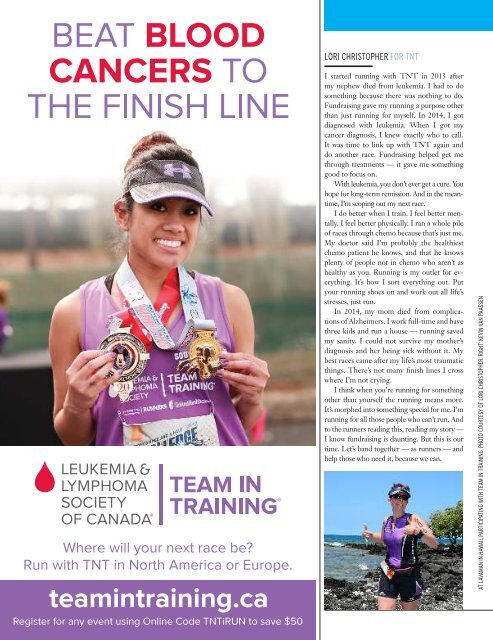iRun - Issue 6 October 2016
Create successful ePaper yourself
Turn your PDF publications into a flip-book with our unique Google optimized e-Paper software.
LORI CHRISTOPHER FOR TNT<br />
I started running with TNT in 2013 after<br />
my nephew died from leukemia. I had to do<br />
something because there was nothing to do.<br />
Fundraising gave my running a purpose other<br />
than just running for myself. In 2014, I got<br />
diagnosed with leukemia. When I got my<br />
cancer diagnosis, I knew exactly who to call.<br />
It was time to link up with TNT again and<br />
do another race. Fundraising helped get me<br />
through treatments — it gave me something<br />
good to focus on.<br />
With leukemia, you don’t ever get a cure. You<br />
hope for long-term remission. And in the meantime,<br />
I’m scoping out my next race.<br />
I do better when I train. I feel better mentally.<br />
I feel better physically. I ran a whole pile<br />
of races through chemo because that’s just me.<br />
My doctor said I’m probably the healthiest<br />
chemo patient he knows, and that he knows<br />
plenty of people not in chemo who aren’t as<br />
healthy as you. Running is my outlet for everything.<br />
It’s how I sort everything out. Put<br />
your running shoes on and work out all life’s<br />
stresses, just run.<br />
In 2014, my mom died from complications<br />
of Alzheimers. I work full-time and have<br />
three kids and run a house — running saved<br />
my sanity. I could not survive my mother’s<br />
diagnosis and her being sick without it. My<br />
best races came after my life’s most traumatic<br />
things. There’s not many finish lines I cross<br />
where I’m not crying.<br />
I think when you’re running for something<br />
other than yourself the running means more.<br />
It’s morphed into something special for me. I’m<br />
running for all those people who can’t run. And<br />
to the runners reading this, reading my story —<br />
I know fundraising is daunting. But this is our<br />
time. Let’s band together — as runners — and<br />
help those who need it, because we can.<br />
AT LAVAMAN IN HAWAII, PARTICIPATING WITH TEAM IN TRAINING. PHOTO COURTESY OF LORI CHRISTOPHER. RIGHT: KEVIN VAN PAASSEN<br />
WHAT DOES<br />
VISION IMPAIRED<br />
LOOK LIKE?<br />
IT’S IMPORTANT<br />
TO CREATE<br />
AWARENESS.<br />
RHONDA MARIE-AVERY<br />
FOR ACHILLES CANADA<br />
You come to a place in your life where you know<br />
in order to care about someone else’s needs intensely,<br />
you have to take care of yourself. The<br />
only way to calm my youngest boy down, who<br />
has ADHD, was put him in the jogging stroller.<br />
I was diagnosed legally blind when I was three.<br />
Before that, I was told to stop misbehaving, instead<br />
of being led by someone across the playground<br />
to the slide. I hooked up with Achilles<br />
Canada, a non-profit that encourages people<br />
with disabilities to run, and they taught me how<br />
to be brave enough to accelerate knowing that<br />
there’s the potential of hitting a car.<br />
My son continued needing me in a way<br />
that I had to be super focussed and so I began<br />
running and it helped me be my best me,<br />
to help him.<br />
The culture doesn’t even know it discriminates<br />
against people with disabilities and so<br />
I think my visibility helps in order to have<br />
conversations. “People with disabilities can’t<br />
do that,” is a lot of people’s viewpoints and<br />
it’s one of the reasons I run: what does visionimpaired<br />
look like? A vision-impaired mother<br />
just ran the Bruce Trail! It’s important to create<br />
awareness. It’s one thing to have values<br />
and speak about them, but if you’re not willing<br />
to get on the front lines and work, you<br />
should stop talking: you can’t stand up for<br />
change sitting down.<br />
People tell me stories of their uncle who<br />
lost their vision and how they struggle losing<br />
their independence. It doesn’t have to be that<br />
way! Other disabled people who aren’t athletes<br />
are saying things like, ‘If you’re running in the<br />
mountains, I don’t have to be afraid to go to<br />
the grocery store.’ See, my every<br />
day isn’t this big adventure. Can<br />
I make it to the bus stop without<br />
getting run over? Can I pick my<br />
son up from high school?<br />
We don’t know how as a society<br />
to help people fit in like that<br />
and we need to talk about that<br />
more.<br />
There’s a place for people with<br />
disabilities. And it’s definitely not<br />
on the sidelines where we’re put.<br />
CHARITYISSUE<br />
16 2015 ISSUE 06 <strong>iRun</strong> to lorem ipsum something goes here tktktktk. — Name Name, Province<br />
<strong>iRun</strong>.ca 17


